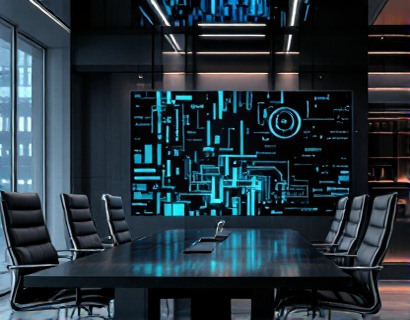Maximizing Architecture Firm Efficiency with Advanced Software Solutions
In the dynamic field of architecture, the integration of advanced software solutions has become pivotal in transforming how firms manage their operations and deliver exceptional user experiences. These technologies are not merely tools but transformative forces that optimize internal processes, streamline management, and enhance collaboration among team members. By leveraging these innovations, architecture firms can redirect their focus towards creative excellence, ensuring that the core mission of designing innovative and functional spaces remains at the forefront.
Streamlining Internal Processes
The backbone of any successful architecture firm is efficient internal management. Advanced software solutions play a crucial role in automating routine tasks, reducing manual errors, and improving overall productivity. Project management tools, for instance, allow firms to track progress in real-time, assign tasks efficiently, and ensure that deadlines are met without compromising on quality. These platforms provide a centralized hub where all project-related information is stored and accessible, minimizing the need for constant email exchanges and physical meetings.
Resource management is another area where software solutions excel. By integrating with various tools and platforms, these solutions offer a comprehensive view of available resources, including personnel, equipment, and materials. This visibility enables better planning and allocation, reducing downtime and ensuring that projects stay on track. For instance, software can automatically notify team members when resources are low or when equipment is available for use, thereby eliminating delays caused by resource unavailability.
Enhancing User Experience
The user experience extends beyond the end-users of the architectural designs to encompass the clients, team members, and stakeholders involved in the project. Advanced software solutions facilitate seamless communication and collaboration, ensuring that everyone is on the same page. Cloud-based platforms enable real-time collaboration, allowing team members to work on the same document simultaneously, regardless of their physical location. This not only speeds up the design process but also fosters a more inclusive and dynamic work environment.
Client interaction is a critical component of the architecture firm's success. Software solutions provide tools for managing client relationships effectively. From initial consultations to project handovers, these platforms offer features such as customizable dashboards, progress reports, and feedback mechanisms. This ensures that clients have a transparent view of the project's status and can provide input at any stage, enhancing their overall satisfaction and trust in the firm.
Boosting Productivity and Collaboration
Productivity is a key metric for any business, and in the architecture sector, it is particularly crucial given the complexity and time-sensitive nature of projects. Advanced software solutions are designed to boost productivity by automating repetitive tasks, providing intelligent suggestions, and optimizing workflows. For example, design automation tools can generate multiple design options based on predefined parameters, saving time and allowing architects to explore a wider range of creative possibilities.
Collaboration is another area where these solutions shine. By breaking down silos between different departments and stakeholders, software platforms foster a more integrated approach to project management. Integrated communication tools, such as chat, video conferencing, and file sharing, ensure that team members can collaborate effectively, regardless of their location. This is particularly beneficial for firms with remote workers or those operating across multiple time zones.
Case Studies and Real-World Applications
To illustrate the impact of advanced software solutions in architecture firms, consider a few real-world examples. A mid-sized firm in New York leveraged a comprehensive project management tool to streamline their workflow. Within six months, they reported a 30% reduction in project delays and a 25% increase in client satisfaction scores. The tool's ability to provide real-time updates and centralized resource management was pivotal in achieving these results.
Another example is a large international firm that implemented a cloud-based design collaboration platform. This move not only enhanced collaboration among global teams but also reduced the time required for design reviews and approvals by 40%. The firm's ability to respond quickly to client needs and market changes has been a significant factor in their competitive edge.
Challenges and Considerations
While the benefits of advanced software solutions are clear, architecture firms must also be aware of potential challenges and considerations. One of the primary concerns is the initial cost of implementation, which can be substantial. However, the long-term savings in operational efficiency and the reduction in errors often offset these costs. Firms should conduct a thorough cost-benefit analysis to ensure that the investment aligns with their strategic goals.
Another consideration is the need for proper training and support. Introducing new software can be daunting for team members, especially if they are accustomed to traditional methods. Providing comprehensive training programs and ongoing support is essential to ensure a smooth transition and maximize the software's potential. Firms should also consider the scalability of the solution, ensuring it can grow with the business and adapt to future needs.
Future Trends in Architecture Software
The landscape of architecture software is continually evolving, driven by advancements in technology such as artificial intelligence, virtual reality, and the Internet of Things (IoT). AI-powered tools are beginning to play a significant role in design processes, offering predictive analytics and intelligent recommendations that can enhance creativity and efficiency. Virtual reality, on the other hand, is transforming the way architects present and experience designs, allowing clients to walk through virtual models before construction begins.
IoT integration is another emerging trend, enabling the creation of smart buildings that optimize energy usage, enhance security, and improve occupant comfort. Architecture firms that adopt these technologies early on will be better positioned to meet the demands of a rapidly changing market and deliver innovative solutions that set them apart from competitors.
Conclusion
In conclusion, advanced software solutions are revolutionizing the way architecture firms operate, offering unparalleled opportunities to streamline management, enhance user experience, and boost productivity. By embracing these technologies, firms can focus more on creative excellence while ensuring that their business operations run smoothly. As the industry continues to evolve, staying informed about the latest trends and tools will be crucial for maintaining a competitive edge and delivering exceptional results.










































